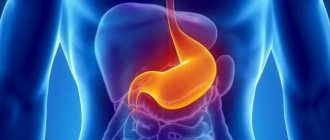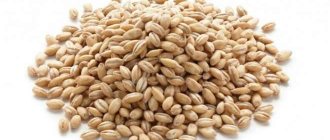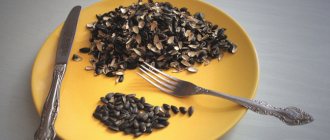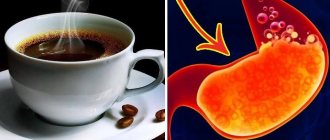The main role of the stomach
The empty cavity holds up to 0.5 liters and has a length of up to 20 cm.
The back and front walls of the stomach are in contact with each other. The maximum filling of the stomach is up to 1.5 liters. Muscle muscles provide contraction and stretching of food at the time of digestion and transition of the food bolus into the intestinal cavity. With systematic overeating, a person’s stomach can stretch to the volume of a 3-liter reservoir. The size of the formed stomach of an adult depends on many factors:
- genetically determined factors;
- anatomical structure of internal organs;
- anomalies in the size and structure of the stomach;
- food culture;
- pathological processes in the gastrointestinal tract.
The stomach is a complex organ. The mucous tissues of the stomach produce gastric juice, under the influence of which food is broken down and crushed into molecular components.
The size of an adult's stomach allows it to produce more hydrochloric acid in gastric juice. Hydrochloric acid, which is part of the gastric juice, performs important functions:
- breaks down complex components into simple ones;
- disinfects food components;
- converts iron for better absorption into the blood.
Gastric juice produces special enzymes that protect the delicate mucous membrane of the organ from the aggressive effects of food, external or internal negative factors. The mucus produced prevents the processes of self-digestion of organ tissues. Fermentation of gastric juice occurs already at the moment of eating, sometimes even when thinking about food during relative hunger.
https://youtu.be/PIgMX-R9dPo
Basic functions of the stomach
All incoming food is ground in the stomach and turns into mush. It is affected by gastric juice, which contains various enzymes, including protein substances. The primary breakdown of fats also occurs in the main digestive organ.
In addition, the process of absorption of water, sugar and carbohydrates into the mucous membranes occurs in the stomach. Then the pulp begins to enter the duodenum in small portions.
Harmful microorganisms also enter the stomach from the external environment. Their quantity is regulated to some extent by salivary enzymes. But even insufficient chewing of foods significantly increases the number of microbes. Hydrochloric acid, which is part of the gastric juice, takes part in regulating the number of microorganisms.
In addition to digesting food, the stomach complements the excretory function of the lungs and kidneys. With the development of respiratory diseases, its role increases several times. It is for this reason that it is important to chew food thoroughly and eat properly, especially when various respiratory diseases occur.
According to experts, the excretion function is performed by the parietal cells of the mucosa. All substances that are to be excreted are initially excreted into the stomach with gastric juice. Then they enter the intestines and are removed along with the feces.
The openings of the mucous membrane of the digestive organ also perform a certain function. They synthesize hormones to regulate the process of food digestion.
Organ size in adults and children
An organ such as the stomach is located in the upper part of the abdomen, extending slightly into the hypochondrium. It is a hollow organ that resembles a chamber. The inside consists of muscle structures and mucous membrane. The area where the stomach is located is commonly called the epigastric zone.
The size of the organ in an adult and a child differs significantly from each other.
The stomach volume of a newly born baby does not exceed the size of a small cherry. On the first day, the baby's chamber can only hold 5-7 milliliters of food. The stomach at this age does not have the opportunity to stretch. Its walls remain hard, which is why newborns burp.
On the 3-4th day of life, the capacity of the gastric pouch increases to 20-25 milliliters. Therefore, mothers are advised to feed their baby often, but little by little. The walls already acquire elasticity, so they have the ability to stretch.
On the 7th day of life, the volume increases to 45-60 milliliters. And when the baby turns one month old, the capacity reaches 80-150 milliliters.
A baby is considered a child between one month and one year old. During this time, the small organism begins to actively grow and gets used to all external conditions. If a newborn baby’s volume is about 30 milliliters, then by 3 months it increases to 100-150 milliliters, depending on weight. By the end of the first year, the stomach can hold approximately 250 milliliters.
The volume of a human stomach at the age of 2 years is in the range of 350-400 milliliters. The child can already eat not only liquid, but also solid food. In children aged 4-5 years, the volume of an empty stomach increases to 450 milliliters.
By the age of 8, the capacity reaches 500 milliliters. At this age, we can already say that the size of the stomach is approaching that of an adult. But the development of the organ is not yet completed. To ensure that the digestive tract can function normally, children are advised to give soft and hard foods, but cut into small pieces.
The size of an adult's stomach in an inactive state is half a liter. But the walls are highly elastic, and therefore stretch and hold up to 2-4 liters of food. When full, the stomach is 26 centimeters long and 14-16 centimeters wide.
The initial volume of the organ in obese and thin people is considered the same. But with constant and excessive consumption of food, it can become very stretched, which will affect the appearance of excess weight.
The average volume of the gastric cavity can also depend on many factors such as:
- genetic predisposition;
- anatomical structure of internal organs;
- abnormalities in the size and structure of the stomach;
- the presence of pathological processes in the digestive organs.
The stomach is a complex organ in structure. The mucous membrane produces gastric juice, under the influence of which food is broken down and crushed to the molecular level.
In a newborn
The capacity of the ventricle of a newly born baby is small, slightly larger than a thimble. A child can eat no more than 5 or 7 ml of food. The organ in a newborn does not stretch, its walls remain hard, so babies are characterized by belching, which relieves them of excess food. Very quickly, approximately on day 3, the capacity of the ventricle increases immediately to 22-25 ml.
Therefore, feeding is recommended frequently, but in small portions. Gradually, the baby’s ventricle becomes elastic and acquires the ability to stretch. A week after birth, the size of the ventricle increases slightly, and by the end of the 2nd week of life it becomes the size of a small chicken egg.
How to determine the location of the stomach?
The stomach is located in the upper section of the abdominal cavity, when its filling occurs - if it is moderate - ¾ of the organ is located on the left side under the ribs, ¼ in the epigastrium. Its displacement can also be affected by breathing, during which filling of nearby organs occurs. However, the input department and the output department are not very mobile.
- If the body type is brachymorphic, the stomach in its shape resembles a horn, located almost transversely.
- In cases where the type of structure is dolichomorphic, it is similar to a long stocking, which is located in an almost vertical position, sharply bending to the right in the lower part.
- With a mesomorphic type of build, the gastric shape is like a hook - the long axis is directed from top to bottom, from left to right.
The stomach is located in the upper part of the abdominal cavity, under the esophagus, the lower part ends above the intestines. The main function of the organ is the accumulation and digestion of food. Most of it is located under the ribs, it is slightly shifted to the left. Another quarter is located in the so-called epigastrium (solar plexus area). The lower part, as a rule, determines the diagnosis.
In a newborn
The capacity of the ventricle of a newly born baby is small, slightly larger than a thimble. A child can eat no more than 5 or 7 ml of food. The organ in a newborn does not stretch, its walls remain hard, so babies are characterized by belching, which relieves them of excess food. Very quickly, approximately on day 3, the capacity of the ventricle increases immediately to 22-25 ml.
Therefore, feeding is recommended frequently, but in small portions. Gradually, the baby’s ventricle becomes elastic and acquires the ability to stretch. A week after birth, the size of the ventricle increases slightly, and by the end of the 2nd week of life it becomes the size of a small chicken egg.
Reasons for changes in the volume of the human stomach
Clinicians in the gastroenterological field of medicine conventionally determine the normal capacity of an adult stomach to 2 fists, up to 20 cm in length and about 6-8 in width. These sizes are applicable for an empty (empty) stomach. When full, the volume of the human stomach can reach 4 liters. Filling an organ with food is not the only cause of pathological stretching of the walls. The main causes of sprains include:
- non-compliance with the drinking regime (drinking large amounts);
- huge single portions with frequent consumption;
- snacks, lack of routine;
- stress, mental disorders;
- drug treatment;
- developmental anomalies of the organ and adjacent structures.
Slimness while following a diet
The volume of an adult’s stomach also depends on the speed of food digestion. When the processes are slow, stagnation is observed, which is accompanied by the muscles remaining relaxed for a long time. This contributes to a decrease in muscle tone, which leads to pathological stretching. People with distended stomachs do not feel full for a long time, which again causes overeating.
- Large single servings of food.
- Excess drinking fluid.
- Frequent under-dose snacking and, as a result, overeating.
We suggest you familiarize yourself with Body Types in Men, How to Determine
The formed mature organ is designed to stretch up to 2.5 liters. With this amount of food and drinks, digestion occurs in the best and most rational way, without requiring additional costs from the body. The habit of having a large lunch and dinner leads to the feeling of fullness coming only when the stomach is full, which sooner or later leads to obesity. This is a case of inattention to oneself and one’s health.
There are, of course, anomalies or the size of the stomach is stretched due to slow digestion. Irreversible changes in size most often occur for these reasons. There are sets of exercises that supposedly can reduce the size of the organ. But opinions on this matter vary: from their absolute benefit to complete uselessness. The only recognized method of reducing the stomach is surgery.
Rating: 86
After eating, the volume of an adult’s stomach increases from 1 to 4 liters, and in its normal state (empty) this value is only 0.5 liters. The size of this organ depends on the person’s physique and the degree of filling. On average, the length of the ventricle reaches 24-26 cm, and if you measure it across, this value can range from 12 to 14 cm.
The gap between the back and front surfaces reaches 8-9 cm. Looking at the lesser and greater curvature, you can see that the distance between them is from 10 to 12 cm, while the same value of an empty stomach reaches only 7-8 cm. If a person is hungry, then the length of the organ reaches from 18 to 20 cm, and the back and front walls touch each other. The stomach of a healthy adult can hold up to 3 liters of food, and if it is empty, then, when contracting, it has a size of up to 0.5 ml.
Development and size of the newborn ventricle
If we consider the shape and volume of a newborn’s stomach, we can see that the organ looks like a thimble. When feeding, the one-time food intake on the first day should be from 5 to 7 ml. From this it becomes clear that the capacity of a newborn’s stomach is small. At birth, this organ is located horizontally, the muscular “lock” is poorly developed, but the pylorus (the sphincter that separates this organ from the small intestines) functions well (Fig. 1).
All of the baby's organs are formed in the womb, but the methods of feeding through the umbilical cord and through the gastrointestinal tract differ.
Figure 1. Development and size of the newborn ventricle.
The baby’s body needs some time to adapt. During this period, the stomach gets used to stable operation and trains. Typically, a newborn feeds on colostrum, which is unique in nature. Not only in the first days of a child’s life, but also with subsequent uses of this product, the body is given the opportunity to cover all the necessary biological needs, and the ventricle gradually begins to work in the desired mode.
During the first 3 days, the ventricle begins to grow and reaches a volume of 24 to 27 ml. Then it gradually increases and after 14 days reaches the size of a chicken egg. Next, this organ gradually forms, and the size of the stomach changes, because it is directly proportional to the baby’s growth. Already by 1 month of a child’s life, its capacity increases to 100 ml, by 3 months - to 150 ml, and by a year this value can be about 300 ml.
What are the size and shape of the stomach
The main digestive organ is located directly below the esophagus in the upper abdominal cavity. Its lower part is located above the intestines. We can say that the organ is slightly shifted to the left and its main part is protected by the ribs.
The size of the stomach is not the same in people, since many factors influence the volume of this organ:
- Build;
- Age;
- Volumes of food consumption;
- The size and condition of organs located nearby.
The shape and size of the stomach constantly changes depending on the amount of food eaten and the position of the person’s body. In addition, the shape of the stomach is determined by the body type. Thus, in people of a brachymorphic body type, the stomach has the shape of a horn and is located almost transversely. In people of the dolichomorphic type, the stomach resembles an elongated stocking, located almost vertically and sharply bending to the right at the bottom.
Finally, if the body type is mesomorphic, the stomach has the shape of a hook: its long axis is directed from top to bottom and from left to right. The length of an empty stomach in an adult is 18-20 cm, width - 7-8 cm. With moderate filling, the length of the organ reaches 24-26 cm, and width - 10-12 cm. The capacity of the stomach ranges from 1.5 to 4 liters.
A full stomach makes it difficult and slows down the digestion of food, so it is better to eat regularly and in small portions.
Reasons leading to stretching
Gastroenterologists determine the normal volume of the stomach conditionally. The capacity of the organ can reach up to 2 fists. Such sizes are acceptable only for an empty stomach. When food comes in, the volume of the human stomach increases significantly.
Many people don’t even know how many liters a person’s stomach is. The normal volume should not exceed 4 liters. If the walls are stretched, then it is customary to talk about the development of a pathological condition.
There are several causes of sprains such as:
- non-compliance with drinking regime. That is, an adult drinks more liquid than expected;
- eating large amounts of food at one time;
- constant snacking and lack of a specific diet;
- the presence of regular stressful situations and mental disorders;
- carrying out drug therapy;
- abnormalities in the development of the stomach and neighboring organs.
How much a person’s stomach can hold depends on the speed of food digestion. If stagnation is observed, it means that the muscle structures are in a relaxed state. This leads to stretching of the organ. A person with a distended stomach does not feel full.
Rating: 86
Does water stretch the stomach?
Many of us are accustomed to hearing about the need to drink 1.5-2 liters of water a day, without going into the details of these recommendations. There are widespread concerns that such volumes contribute to stretching of the stomach walls. This is nothing more than a myth. Water does not stay in the body for a long time, passing through it in transit, and it is needed only for metabolism.
Drinking large amounts of water does not affect the size of the stomach.
In addition, each body is individual; there are simply no universal norms for fluid intake. It all depends on metabolic processes, the pace of physical activity, the surrounding climate, hormonal levels, the state of the gastrointestinal tract and the amount of food taken. Water is needed to dissolve and flush the foods you eat from your body. The more we eat, the more water the body requires. Accordingly, food stretches the stomach, not water. After regulating the eating regimen, the drinking regimen is inevitably adjusted.
Consequences of overeating
If you do not adhere to a diet, systematically overeat and snack on heavy foods, this will lead to stretching of the walls. The large capacity of the organ causes a number of problems in humans in the form of:
- weight gain and obesity;
- difficulty breathing due to compression of the pulmonary structures;
- chronic tachycardia;
- slowing down the flow of blood to the spleen. In such cases, the human body wants to sleep strongly;
- the appearance of hepatic colic on the right side of the abdomen.
With regular overeating, compression of internal organs is observed. The intestinal canal is particularly affected. The food bolus is pressed and turns to stone. This process prevents the deposition and passage of feces to the rectum. Against this background, constant constipation develops, intoxication of the body and poor health appear.
If the diet is not followed, with systematic overeating, snacking on heavy, hard-to-digest food, the stomach cavity stretches, and the muscle structures cease to provide the necessary contraction. A distended stomach in a person negatively affects human health, leading to the following complications:
- increase in body weight, up to the development of obesity;
- difficulty breathing (due to compression of the pulmonary structures);
- chronic tachycardia (complication of cardiac history);
- slowing down blood flow to the spleen (provokes the desire to sleep);
- hepatic colic (due to compression of the liver on the right).
We invite you to familiarize yourself with how fat burners work for men and women: how to choose the best ones
With systematic overeating and compression of internal organs, the intestines also suffer. Food masses are pressed, petrified, and prevent deposition and passage to the rectum. Hence constipation, weight gain, mild intoxication of the body, and poor health. The volume of food at one time should not exceed 0.5 liters. Therapeutic nutritional methods include fractional meals of 300 ml per serving.
Fast food and snacks
Modern gastroenterology and surgery can solve a number of problems with a distended stomach. To reduce the volume, surgical resection (gastroplasty) is often used. Indications for surgery may include dysfunction of vital organs, poor health, life-threatening heart complications, excess weight (including the late stages of obesity), and diabetes mellitus.
Existing methods of practical medicine in the field of dietetics and physical therapy make it possible to restore the previous muscle tone of the stomach cavity, speed up digestive processes, and improve the health of the body of a patient of any age. Following a healthy lifestyle and simple recommendations from doctors, patients achieve good therapeutic results: weight loss, blood pressure and cardiac activity normalize, and the overall quality of life increases.
Contraindications for reducing the size of the stomach
There is a list of body conditions in which influencing the walls of the stomach in order to reduce the size of the organ is strictly contraindicated. This list includes diseases of the gastrointestinal tract or processes indicating their development:
- A developing type of peptic ulcer, which is currently in a chronic or acute form, with a probable risk of internal bleeding.
- Inflammation of the stomach, which, if a stomach reduction program is started, can develop into an acute form with the appearance of severe spasms and pain.
- Lack of vitamins, minerals and other nutrients in the body. Any unreasonable dietary restriction will ultimately lead to the body suffering from even greater exhaustion. As a result, everything may not end well; you will need hospitalization in the gastroenterology department.
- Diabetes mellitus is insulin- and non-insulin-dependent. This disease of the endocrine system requires the preparation of a special dietary menu, so it is unacceptable to reduce the size of the stomach using natural methods, such as diet. It is possible to resort to surgical intervention.
- Tendency to disrupt the intestinal microflora and defecation disorders in the form of prolonged constipation, which lasts more than 3 days, or in the form of diarrhea, which manifests itself without any reason.
- Chronic inflammation of the pancreas or gallbladder, when the functionality of the tissues of the gallbladder and pancreas is significantly deteriorated.
- Malignant neoplasms in the gastrointestinal tract, requiring urgent treatment and the choice of a specialized diet.
The stomach and the processes occurring in it
The stomach can change its shape depending on the amount of food consumed.
When empty, the volume of the stomach is approximately 0.5 liters, with a length of 18-20 cm. The walls, back and front, are shifted, almost touching each other. As the stomach fills, it expands to one and a half liters. The walls are moved to a distance of 8-10 cm from each other. This is within normal limits.
In case of overeating, the stomach can expand to a volume of 3 liters. There are known cases of stretching up to 4l. The size of this organ depends on the height and build of a person, on his nutritional culture, that is, on how, what, and how much food he consumes daily.
Despite its apparent simplicity, the stomach is a rather complex organ, the walls of which contain numerous and varied glands, endocrine cells involved in the work of the whole organism. The gastric mucosa produces gastric juice, which saturates food coming from outside and performs the first stage of its breakdown into various components.
- interacts with protein, breaking it down into components,
- destroys harmful organisms that enter the stomach along with food,
- Converts ferrous iron to ferric iron, which is necessary for the formation of blood.
Gastric juice also produces enzymes involved in the breakdown of proteins and fats, and mucus, which lines the walls of the stomach and protects it from the aggressive environment of HCl. Mucus produced during digestion also protects the stomach from self-digestion. Gastric juice begins to be produced before eating.
Functions of hydrochloric acid
The size of the organ in an adult makes it possible to produce more hydrochloric acid in gastric juice than in children. It consists of several components that are responsible for providing several functions in the form of:
- breaking down complex components into simple ones;
- disinfection of food components;
- transforming iron so that it is better absorbed into the blood.
Gastric juice contains some enzymes. They protect the mucous membrane of the organ from the aggressive effects of food, external and internal factors. The mucus produced prevents the processes of self-digestion of the tissue structures of the organ. Fermentation of gastric juice is observed at the moment when thoughts of hunger arise.
The structure of the digestive organ
This is a hollow organ in the shape of the Latin letter J in the upper part connected to the esophagus, and in the lower part to the small intestine.
Its walls consist of several layers:
- The mucous membrane of this organ consists of epithelial cells and glands. Mucosal cells produce a gel-like substance - mucus, saturated with glycoproteins and polycarbonates, which protect organ tissue from gastric acid. In a healthy stomach, the entire inside is covered with this mucus. The mucosa contains many enzymatic, secretory and endocrine glands; they produce hydrochloric acid, pepsinogens, hormones (motilin, histamine, serotonin, etc.) and enzymes that form gastric juice.
- The muscular layer is responsible for motor function, that is, for mixing and moving food. The shell has a three-layer structure . It contains longitudinal, circular and oblique muscles.
- The outer layer is serous. This is a thin film of epithelium that covers almost all the internal organs of the abdominal cavity. It produces a fluid that lubricates the walls of internal organs to reduce friction between them. It contains sensitive nerve endings and lymphatic vessels that are responsible for pain.
The organ itself is divided into 4 parts:
- Cardiac part - past cardiaca. It got its name due to its close location to the heart. This is the junction with the esophagus, which is called the cardiac sphincter. This is a kind of valve that prevents food from returning from the stomach back to the esophagus.
- To the left of the cardiac portion is a dome-shaped vault called the gastric fundus . Air that comes with food accumulates there.
- The largest region is the one that starts from the cardiac part and ends with the pylorus, it is called the body of the stomach.
- The pylorus, or pylorus, consists of a canal and a cave. The cave contains incompletely digested food, and the channel is responsible for moving the contents of the cave into the duodenum. The pylorus is the junction of the stomach and the duodenum.
What should an adult eat?
An adult's diet should include proteins, fats, and carbohydrates.
For normal functioning of an adult body, it must receive daily:
- Water. The human body is 80 percent water. Water is life. It is found in the tissues and cells of our body, in the blood; water helps remove toxins from the body. Water should be drunk not only in tea, coffee or juices. The body must receive clean, preferably unboiled water.
- Proteins are a source of material that serves to build body cells. Proteins are of plant and animal origin. They are found in meat, eggs, dairy products, legumes and grains.
- Fats are a source of concentrated energy. They can remain in the body for a long time in the form of fat deposits. Sources of fats are vegetable oils, lard, animal fat, and butter. And some high-fat dairy products.
- Carbohydrates are a source of energy that is immediately consumed by the body. True, if a person leads a sedentary lifestyle or consumes them in increased quantities, carbohydrates can also be converted into fat deposits.
- Antioxidant vitamins, nicotinic and other acids are necessary for the body to function normally and are found in almost all foods, especially in vegetables and fruits.
Food for an adult
For the gastric chamber to function normally, the adult body must receive:
- water. As you know, the body consists of 80% liquid. It is found in tissue and cellular structures, in the blood and lymph. With its help, it is possible to remove toxic components and toxins. You need not only to drink tea, juices and coffee, but also simple purified water without gases;
- protein compounds. Such components are responsible for building the cells of the body. They come in plant and animal origin. Contained in dairy products, legumes and grains;
- fats. These substances are a source of energy. They can remain in the body as fat deposits for a long time. They are found in vegetable oils, lard, internal fat of animals, butter;
- carbohydrates. Another source of energy. When they enter the body, they are immediately consumed. If a person leads a sedentary lifestyle or eats them in large quantities, then they are converted into fat deposits;
- antioxidant vitamins. You need to choose those products that contain nicotinic and other acids. They are needed for the normal functionality of the digestive system. They are found in large quantities in vegetable and fruit crops.
We invite you to familiarize yourself with Order the Inna Volovicheva diet disk
To prevent overeating and prevent stomach distension, you need to lead an active lifestyle. If a person has a sedentary job, then he should go out every evening and take walks. Regular exercise and doing activities you enjoy will also help.
If your stomach is very distended, then you should think about losing weight. A nutritionist will help solve the problem.
Reversibility of the process and methods of correction
A distended stomach is not a death sentence. You can return it to normal physiological sizes using radical or natural methods. The first are surgical interventions. The second involves performing special physical exercises and correcting nutrition.
Surgical methods
Gastric resection
Resection using the Billroth method.
Resection is the removal of part of the stomach by excision. Today, this technique is considered outdated, but is still valid in some hospitals. In essence, it is a cavity surgical intervention, which rarely goes unnoticed for the patient. During the operation itself, you can lose a lot of blood. Upon completion, a number of unpleasant “surprises” may also arise: the risk of internal bleeding, the likelihood of dehiscence and suppuration of the sutures, complications in the form of impaired digestive function, pancreatitis, etc. Read more about gastric resection here.
Bandaging
Banding is a correction of the size of an organ by applying a “blockade” in the form of a restrictive ring to part of it. The digestive organ is divided into two chambers: the upper, smaller one, is quickly filled with food, as a result of which the brain quickly receives a signal of saturation. Then food from this chamber moves to the lower one, where it is digested. This method also involves abdominal surgery with all its disadvantages. In addition, the patient may experience difficulty passing food through the ring area and the development of gastritis and peptic ulcers.
Gastroplasty
Vertical gastroplasty is a complex manipulation in which the upper part of the organ is transformed into a continuation of the esophagus. This is done for the same purpose as with banding (an accelerated feeling of satiety), but it also has the same disadvantages.
Ballooning
Ballooning is an endoscopic surgical method that involves inserting a balloon filled with liquid into the stomach. If you delve into the essence of the operation, it becomes clear that the size of the stomach does not decrease with this method. The container simply takes up a certain amount of space intended for food. The probable consequences of ballooning are quite serious: the risk of pressure sores of the walls of the operated organ and the closure of the exit to the duodenum.
Natural Methods
Special gymnastics
A few simple physical exercises borrowed from yoga will help work the diaphragm and strengthen all the muscles of the body:
- Breathing while lying down. It is necessary to lie down on a hard horizontal surface and slowly take a deep breath, carefully drawing in the anterior abdominal wall below the ribs. Then also slowly exhale. And so on for at least 10 approaches, each time trying to draw in the stomach more strongly.
- "Breath of a Dog" Starting position – half lotus position, back straight. Next, inhale three times through the nose, then exhale three times - as animals do when running.
- "Cup". Lying on your back, you need to alternately inhale and exhale, arching your body so that the retracted stomach resembles the shape of a bowl. In this case, your hands should be kept behind your head. For the first time, 4-6 times will be enough; in the future, the number of approaches can be increased.
Regular running, race walking, oriental belly dancing and jumping rope will also benefit.
https://youtu.be/PJG1AuMWxRM
Diet correction
Small meals, mandatory breakfast, consumption of foods rich in fiber (cabbage, carrots, beans, spinach, cereals, lentils, apples, bananas), minimizing salt and spices, avoiding sour, fatty foods and alcohol. Consume fruit in small portions at least half an hour before meals. Chewing food slowly.
It is not recommended to eat too hot foods and you should avoid combining food with drinks. It will be much healthier to drink a glass of water 30 minutes before or after a meal.
"The Five Spoon Rule"
In the course of practical work with patients, nutritionists were able to determine the ideal size of a single portion of food, which stimulates the return of the stomach to normal size.
5 tablespoons or 150 g of food - just enough to eat so that the stomach gradually shrinks to the required parameters.
This is enough to satisfy the feeling of hunger and replenish the body’s energy reserves. To achieve a lasting effect, it is recommended to maintain an interval between meals of at least three hours. This approach allows you to return your stomach to its previous size in 3-6 months and tighten your figure.
With the help of a surgeon’s hands, you can quickly achieve your goal, but you must remember that any operation is always a risk for the body’s condition, a certain time for its rehabilitation and the possibility of irreversible consequences. The natural approach to reducing gastric volume requires a lot of time and developed willpower, but allows you to avoid negative results. Which option to choose is up to each person to decide individually.
How to shrink your stomach and lose weight
To reduce the size of your stomach, you can reduce the amount of food you eat.
In order for all the above components to enter the stomach, the diet must be varied. The daily menu may include various cereals, soups, pasta, borscht, stewed vegetables, fresh vegetable salads, meat, fish, etc.
https://www.youtube.com/watch?v=-BDJ6L8S-ls
The question is - how much? Each person decides for himself individually. Someone eats a lot, does not gain weight, and does not suffer from it. Some people eat little and don’t lose weight. Much depends on individual vital activity, on the energy consumption of a particular organism.
But let's return to the stomach. How much can it hold? As practice shows, up to 3 liters. But is it necessary to overload it like that? Let's calculate how much the average Russian eats for lunch. A plate of borscht or soup – 300 grams. Another 250 grams will be the second, 100 grams - bread. 650-700 grams is half the stomach full.
Most nutritionists believe that breakfast should be hearty. What does tight mean? Should I eat more? Organize your breakfast according to the principle: less is more. In other words, make your breakfast energy-rich. Let the food be smaller in volume so as not to waste extra energy carrying a heaviness in the stomach.
It's great if you have walnuts in your diet. This is a charge for the whole day. Do you like salads? Please. But only from sweet fruits and sour cream. Save your diet cabbage salads for the evening. So in the morning you will eat no more than 350 grams (counting tea or coffee), and recharge your energy. By the way, hot drinks in the morning help the body warm up and invigorate.
This can be a saucer of vinaigrette or a nutritious salad, but not more than 100 grams. Between lunch and dinner, the snack should be light in calories. Fruits, a glass of juice, vegetable salad. And for dinner, it is advisable to reduce proteins, fats and carbohydrates to a minimum. Let it be salads and fruit juices with light bran bread. And also no more than 300 grams. Help your body get ready for the coming sleep.
How to shrink a distended stomach naturally at home
The human body is an amazing creation of nature. His ability to adapt is amazing. If you give properly dosed physical activity, the heart will pump more and more blood in order to save energy for itself, as well as to increase the saturation of the body with oxygen.
The stomach is no exception. It is easy to understand how to reduce a distended stomach at home. If smaller volumes of food enter its cavity, it will reduce its volume. Therefore, dietary nutrition is one of the logical ways to reduce the size of an organ. Of course, you will have to use willpower and follow the basic rules, and not everyone can do this.
In order to understand how to reduce a distended stomach, you must adhere to the following principles:
- The daily consumption of food products by weight should not exceed one and a half kilograms (scientists have proven that this mass is best digested, absorbed in the intestines, and does not stretch the walls of organs).
- Since ancient times, it has been customary that there is a first, second and third course, the last often being some kind of liquid. There is a paradox here: you should not wash down your main dishes with water or other liquid.
- It is not recommended to make a mixture of fresh fruits and staple foods. Fruits contain a large amount of dietary fiber, the fermentation process begins, resulting in the formation of a large amount of carbon dioxide, which easily expands the walls of the stomach.
- The liquid should be consumed twenty minutes before eating, and then 2 hours after the meal (together with small portions, this will reduce the secretion of digestive enzymes by the pancreas and gall bladder).
- Eating should last at least twenty minutes, during which time the brain receives information about satiety, and the person does not overeat. In this mode, food must be consumed, chewing it thoroughly.
- The diet should include well-known meals: breakfast, afternoon snack, lunch, snack, dinner. The portions at each meal should be halved; the stomach will begin to get used to such nutrition, thereby reducing the volume. The basic rule is little, but often! Doctors advise increasing the number of meals up to six times. Three full-fledged receptions, three additional ones - the best option. The weight of food taken should be no more than 200 grams. Snacks are designed to prevent a constant feeling of hunger throughout the day due to reduced portions. It is recommended to include vegetable or fruit salads in your snack diet, where you can add nuts and dairy products.
- Fatty, fried, smoked - exclude. The properties of this type of food do not stimulate stomach contraction, but have the opposite effect.
- The basis of the menu is protein dishes, as well as those containing a large amount of fiber. Protein foods are an optimal source of energy and help you feel full faster. It takes a lot of energy to break down proteins, which also plays into your hands. Dietary meat, fish products, dairy products, vegetable salads and stews, and soups are suitable.
- During meals there should be no distracting signals from outside (playing on the computer, watching TV, reading a book). Due to such errors, the signal that the body has already taken the right amount of food comes much later, which also contributes to overeating.
It has been experimentally determined that after two weeks of compliance with these rules, positive dynamics will already be visible. The answer to the question of how to reduce a distended stomach at home is very simple. The main thing is discipline and willpower.











